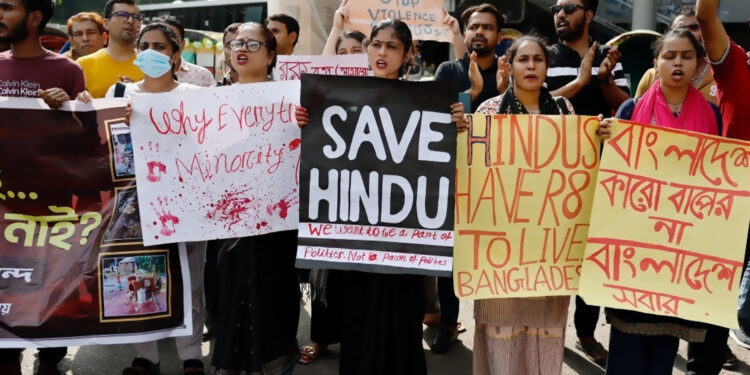The Bangladesh Hindu Genocide evokes a sense of déjà vu when one observes the historical decline of the Hindu population in countries neighboring India such as Pakistan and Afghanistan. This demographic shift demonstrates a concerning pattern of dwindling Hindu communities in the Indian Subcontinent, where persecution, incessant violence, and systemic discrimination have driven Hindus to the brink of extinction. Their fate seems grim, as their numbers continue to shrink, raising questions about their long-term survival and cultural continuity.
Will decline of the Hindu population in Bangladesh be mirroring the plight of Hindus in Pakistan and Afghanistan, which historically once had significant Hindu populations, and which have now been almost wiped out due to forced conversions, communal hatred, violence, and systemic discrimination? Is Bangladesh precariously in the same mode? Or is there still any hope for a different outcome?
One might ponder whether Hindus’ lack of unity and a sense of community has aided in their vulnerability, or where at times Hindu Dharma, with its emphasis on non-violence and spiritual liberation, might be seen wrongly as lacking the assertiveness required for self-preservation in hostile environments.
Are we merely witnessing and documenting Hindu genocide, where their demographic, cultural, and religious identity is systematically being erased? Documenting these events is crucial not only for historical accuracy but also for mobilizing international awareness and action. However, if documentation merely serves to record suffering sans any concrete action, it could be seen as a passive acceptance of a tragic fate.
History is not static, and the future may hold reversals of current trends. History is replete with instances where oppressed communities have reclaimed their space and dignity and the possibility of such reversals offers a glimmer of hope for Hindus facing existential threats. However, such reversals require concerted effort, strategic planning, and a shift in the approach to self-defense and preservation.
The role of government in exacerbating the plight of Hindus cannot be overstated. Bangladesh’s government has failed to protect Hindus and worse, has actively participated in their persecution, the result has been catastrophic.
The consequences of “othering” inherent in the Islamists’ dogma practiced by the marauders has played a key role in the ongoing Hindu persecution. While philosophical and moral arguments are essential, they are insufficient in the face of such grave physical threats. The need for both intellectual and physical protection is paramount. The Hindu concept of “Kshatriyata” (warrior spirit) emphasizes the importance of defending Dharma (righteousness). This principle must be re-emphasized to ensure the survival of Hindus facing existential threats.
The Bangladesh Hindu Genocide is not just a tragedy of the past; it is a present and ongoing danger that demands attention and swift action. By understanding the religious underpinnings, and comparative religious dynamics, we can better ensure the protection and preservation of Dharmic communities. The future may yet hold the potential for change, but it will require a concerted effort to deter repeated pogroms against Hindus and to turn the tide against the bigotry and the persecution of the vulnerable Hindu community in Bangladesh and elsewhere.



![[ HPI ] Kashmiri Pandits’ Emotional Return to Nadimarg Temple After 21 Years](https://hinduvishwa.org/wp-content/uploads/2024/10/Arde-Nareshwar-Temple-780x468-1-75x75.jpg)
![[ India Today ] Ohio senator JD Vance thanks wife, a Hindu, for helping him find Christian faith](https://hinduvishwa.org/wp-content/uploads/2024/06/us-senator-jd-vance-reveals-how-his-hindu-wife-usha-helped-him-find-his-christian-faith-image-re-272530504-16x9_0-120x86.webp)










